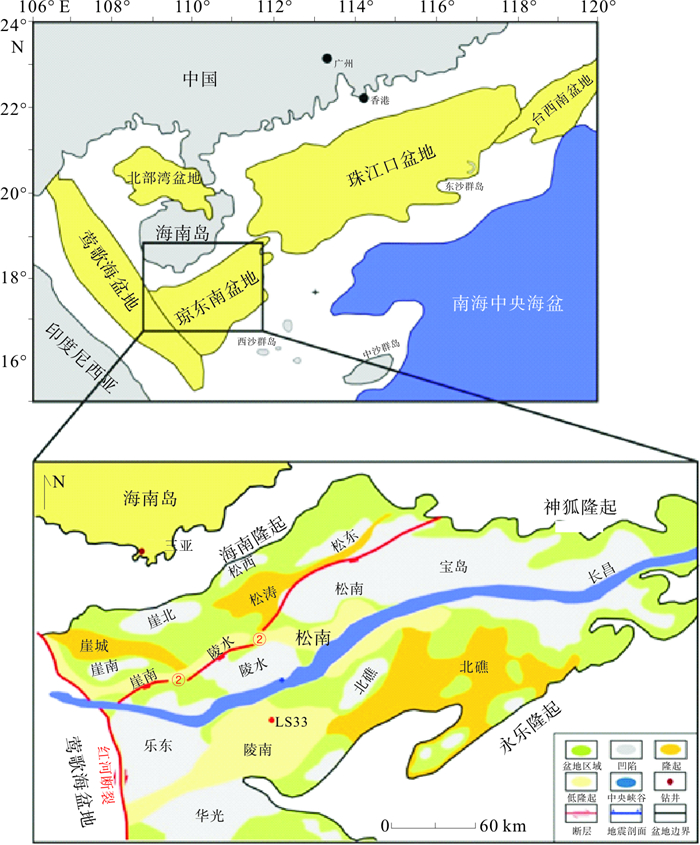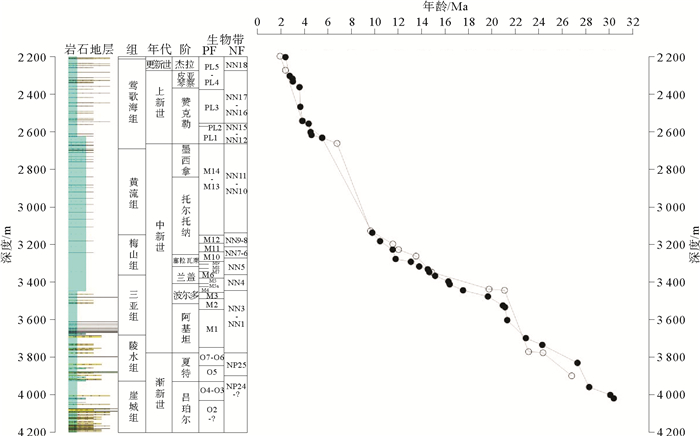NEOGENE PALYNOLOGICAL ASSEMBLAGES FROM QIONGDONGNAN BASIN AND THEIR PALEOCLIMATIC IMPLICATIONS
-
摘要:
以琼东南盆地深水区LS33井岩心为研究对象,通过对孢粉组合序列的分析,探讨渐新世以来各个地质时期的植被类型以及所反映的古气候特征。根据孢粉谱和聚类分析结果,LS33井岩心可划分为8个孢粉组合,不同组合之间孢粉面貌差异巨大。早渐新世,孢粉组合中以蕨类植物为优势组分,多见常绿植物,代表冷干的植物分子罕见,反映了暖湿性的热带亚热带气候。晚渐新世到早中新世,延续了早渐新世暖湿的特点,常绿栎、榛最为繁盛,植被和气候出现较为明显的垂直分带性。早中新世研究区气候发生了重大转折,温带落叶树和高山针叶林树的增多表明气候类型已转至凉干。早中新世至晚中新世常绿树的繁盛和红树科的发育表明气候属于暖湿型。上新世到更新世继承了晚中新世的特点,但红树林逐渐衰退,草本植物逐渐繁盛,意味着气候类型从暖湿逐渐转为凉干。
Abstract:Palynological research plays a significant role in exploration for petroliferous basins. It provides not only evidence for stratigraphic classification, but also information on paleovegetation and paleoclimate. With the palynological assemblages of the Well LS33 from the deepwater area of the Qiongdongnan Basin, this paper discussed the paleovegetation types and paleoclimatic characteristics of the basin since Oligocene. Eight palynological assemblages are identified and variations in assemblages recognized. The Early Oligocene pollen assemblages is dominated by ferns, accompanied by evergreens, with little cool and dry species, representing a tropical or subtropical warm and humid climate. The Late Oligocene to Early Miocene assemblages inherited the warm and humid weather in Early Oligocene. Quercoidites and Momipites are most abundant, with more apparent vertical zonations in both vegetation and climate. However, a stunning change occurred in Early Miocene. An increasing in pollen assemblage of temperate deciduous forest and alpine coniferous forest suggests the climate conditions that changed dramatically to cool and dry. Evergreens and Mangrove were abundant in Early Miocene to Late Miocene, and the climate was warm and humid then. Since Late Miocene, mangrove gradually reduced while herbs increased, which illustrated a conversion from the warm and humid weather to the cool and dry again.
-
Key words:
- palynological assemblages /
- paleoclimate /
- Neogene /
- Qiongdongnan Basin
-

-
图 1 琼东南盆地地理位置、构造单元划分及LS33井位置(据文献[3]修改)
Figure 1.
-
[1] 中华人民共和国石油勘探公司南海分公司, 中华人民共和国地质勘探公司广州分公司, 中国科学院南京地质古生物研究所.南海北部大陆架第三纪古生物图册[M].广东科技出版社, 1981: 1-30.
http://ir.nigpas.ac.cn/handle/332004/6045 South Sea Branch of Petroleum Corporation of the People's Republic of China, China National Geological Exploration Corporation Guangzhou Branch, Nanjing Institute of Geology and Palaeontology, Chinese Academy of Science, Tongji University, China Academy of Geological Science, 1981. Tertiary Palaeontology of North Continental Shelf of South China Sea[M]. Guangzhou: Guangdong Science and Technology Press, 1981: 1-30.
[2] 谢金有, 覃军干, 李君, 等.南海莺琼盆地渐新世—上新世孢粉组合序列及其古环境意义[J].微体古生物学报, 2014, 31(1): 85-97. http://www.cnki.com.cn/Article/CJFDTotal-WSGT201401008.htm
XIE Jinyou, QIN Jungan, LI Jun, et al. Palynological assemblages of the Oligocene and Pliocene in the Yinggehai-Qiongdongnan Basin of the northern South China Sea and their paleoenvironmental implications[J]. Acta Micropalaeontologica Sinica, 2014, 31(1): 85-97. http://www.cnki.com.cn/Article/CJFDTotal-WSGT201401008.htm
[3] Sun Z, Zhai S, Xiu C, et al. Geochemical characteristics and their significances of rare-earth elements in deep-water well core at the Lingnan Low Uplift Area of the Qiongdongnan Basin[J]. Acta Oceanologica Sinica, 2014, 33(12):81-95. doi: 10.1007/s13131-014-0578-3
[4] Sun X, Wang P. How old is the Asian monsoon system?—Palaeobotanical records from China[J]. Palaeogeography Palaeoclimatology Palaeoecology, 2005, 222(4):181-222. http://cn.bing.com/academic/profile?id=396753e69a0b374eb3e5059a9301f50a&encoded=0&v=paper_preview&mkt=zh-cn
[5] 边叶萍, 李家彪, 翦知湣, 等.低纬西太平洋末次冰期以来海洋孢粉记录对海平面变化的不同响应[J].第四纪研究, 2012, 32(6):1078-1086. doi: 10.3969/j.issn.1001-7410.2012.06.03
BIAN Yeping, LI Jiabiao, JIAN Zhimin, et al. The different response of marine pollen records to the sea level change in the low latitude West Pacific since the Last Glacial Period[J]. Quaternary Sciences, 2012, 32(6):1078-1086. doi: 10.3969/j.issn.1001-7410.2012.06.03
[6] 雷作淇.珠江口盆地第三系及红树林孢粉分布规律[J].广东地质, 1998(2):49-54.
LEI Zuoqi. The Tertiary and the distribution regularity of mangrove sporopollen in the Pearl River Mouth Basin[J]. Guangdong Geology, 1998(2):49-54.
[7] 张一凡.琼东南盆地晚新生代生物地层学与古环境重建[D].中国海洋大学, 2016.
ZHANG Yifan. Late Cenozoic Biostratigraphy and Paleoenvironment in Qiongdongnan Basin[D]. Ocean University of China, 2016.
[8] 吴国瑄, 覃军干, 茅绍智.南海深海相渐新统孢粉记录[J].科学通报, 2003, 48(17):1868-1871. doi: 10.3321/j.issn:0023-074X.2003.17.011
WU Guoxuan, QIN Jungan, MAO Shaozhi. The Oligocene record of spore and pollen in South China Sea [J]. Chinese Science Bulletin, 2003, 48 (17):1868-1871. doi: 10.3321/j.issn:0023-074X.2003.17.011
-




 下载:
下载:




